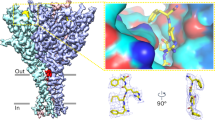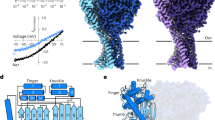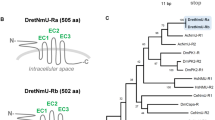Abstract
THE peptide Phe-Met-Arg-Phe-NH2 (FMRFamide) and structurally related peptides are present both in invertebrate and vertebrate nervous systems1,2. Although they constitute a major class of invertebrate peptide neurotransmitters3, the molecular structure of their receptors has not yet been identified. In neurons of the snail Helix aspersa4, as well as in Aplysia bursting5 and motor6 neurons, FMRFamide induces a fast excitatory depolarizing response due to direct activation of an amiloride-sensitive Na+ channel4. We have now isolated a complementary DNA from Helix nervous tissue; when expressed in Xenopus oocytes, it encodes an FMRF-amide-activated Na+ channel (FaNaCh) that can be blocked by amiloride. The corresponding protein shares a very low sequence identity with the previously cloned epithelial Na+ channel subunits7–12 and Caenorhabditis elegans degenerins13–15, but it displays the same overall structural organization. To our knowledge, this is the first characterization of a peptide-gated ionotropic receptor.
This is a preview of subscription content, access via your institution
Access options
Subscribe to this journal
Receive 51 print issues and online access
$199.00 per year
only $3.90 per issue
Buy this article
- Purchase on Springer Link
- Instant access to full article PDF
Prices may be subject to local taxes which are calculated during checkout
Similar content being viewed by others
References
Price, D. A. & Greenberg, M. J. Science 197, 670–671 (1977).
Greenberg, M. J. & Price, D. A. Prog. Brain Res. 92, 25–37 (1992).
Cottrell, G. A. Comp. molec. Neurobiol. 63, 279–285 (1993).
Green, K. A., Falconer, S. W. P. & Cottrell, G. A. Pflügers Arch. 428, 232–240 (1994).
Ruben, P., Johnson, J. W. & Thompson, S. J. Neurosci. 6, 252–259 (1986).
Belkin, K. J. & Abrams, T. W. J. Neurosci. 13, 5139–5152 (1993).
Canessa, C. M., Horisberger, J. D. & Rossier, B. C. Nature 361, 467–470 (1993).
Lingueglia, E., Voilley, N., Waldmann, R., Lazdunski, M. & Barbry P. FEBS. Lett. 318, 95–99 (1993).
Canessa, C. M. et al. Nature 367, 463–467 (1994).
Lingueglia, E. et al. J. biol. Chem. 269, 13736–13739 (1994).
Voilley, N. et al. Proc. natn. Acad. Sci. U.S.A. 91, 247–251 (1994).
Voilley, N. et al. Genomics 28, 560–565 (1995).
Huang, M. & Chalfie, M. Nature 367, 467–470 (1994).
Driscoll, M. & Chalfie, M. Nature 349, 588–593 (1991).
Chalfie, M. & Wolinski, E. Nature 345, 410–416 (1990).
Renard, S., Lingueglia, E., Voilley, N., Lazdunski, M. & Barbry, P. J. biol. Chem. 269, 12981–12986 (1994).
Hong, K. & Driscoll, M. Nature 367, 470–473 (1994).
Waldmann, R., Champigny, G. & Lazdunski, M. J. biol. Chem. 270, 11735–11737 (1995).
Galzi, J. L., Revah, F., Bessis, A. & Changeux, J. P. A. Rev. Pharmac. 31, 37–72 (1991).
Betz, H. Neuron 5, 383–392 (1990).
Maricq, A. V., Peterson, A. S., Brake, A. J., Myers, R. M. & Julius, D. Science 254, 432–437 (1991).
Valera, S. et al. Nature 371, 516–519 (1994).
Brake, A. J., Wagenbach, M. J. & Julius, D. Nature 371, 519–523 (1994).
Galzi, J. L. et al. Nature 359, 500–505 (1992).
Yang, H. Y. T., Fratta, W., Majane, E. A. & Costa, E. Proc. natn. Acad. Sci. U.S.A. 82, 7757–7761 (1985).
Palmer, L. G. A. Rev. Physiol. 54, 51–66 (1992).
Garty, H. FASEB J. 8, 523–528 (1994).
Li, X. J., Blackshaw, S. & Snyder, S. H. Proc. natn. Acad. Sci. U.S.A. 91, 1814–1818 (1994).
Raffa, R. B. Peptides 9, 915–922 (1988).
García-Añoveros, J., Ma, C. & Chalfie, M. Curr. Biol. 5, 441–448 (1995).
Author information
Authors and Affiliations
Rights and permissions
About this article
Cite this article
Lingueglia, E., Champigny, G., Lazdunski, M. et al. Cloning of the amiloride-sensitive FMRFamide peptide-gated sodium channel. Nature 378, 730–733 (1995). https://doi.org/10.1038/378730a0
Received:
Accepted:
Issue Date:
DOI: https://doi.org/10.1038/378730a0
This article is cited by
-
Structural basis for excitatory neuropeptide signaling
Nature Structural & Molecular Biology (2024)
-
Functional analysis in a model sea anemone reveals phylogenetic complexity and a role in cnidocyte discharge of DEG/ENaC ion channels
Communications Biology (2023)
-
Function and phylogeny support the independent evolution of an ASIC-like Deg/ENaC channel in the Placozoa
Communications Biology (2023)
-
Exploring the Therapeutic Effect of Neurotrophins and Neuropeptides in Neurodegenerative Diseases: at a Glance
Molecular Neurobiology (2023)
-
Distribution of FMRFamide-related peptides and co-localization with glutamate in Cupiennius salei, an invertebrate model system
Cell and Tissue Research (2019)
Comments
By submitting a comment you agree to abide by our Terms and Community Guidelines. If you find something abusive or that does not comply with our terms or guidelines please flag it as inappropriate.



